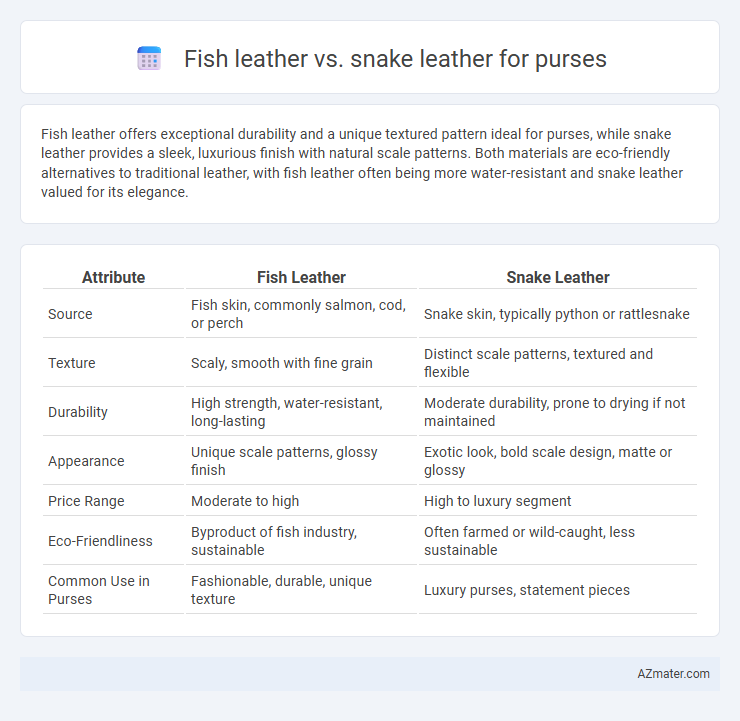Fish leather offers exceptional durability and a unique textured pattern ideal for purses, while snake leather provides a sleek, luxurious finish with natural scale patterns. Both materials are eco-friendly alternatives to traditional leather, with fish leather often being more water-resistant and snake leather valued for its elegance.
Table of Comparison
| Attribute | Fish Leather | Snake Leather |
|---|---|---|
| Source | Fish skin, commonly salmon, cod, or perch | Snake skin, typically python or rattlesnake |
| Texture | Scaly, smooth with fine grain | Distinct scale patterns, textured and flexible |
| Durability | High strength, water-resistant, long-lasting | Moderate durability, prone to drying if not maintained |
| Appearance | Unique scale patterns, glossy finish | Exotic look, bold scale design, matte or glossy |
| Price Range | Moderate to high | High to luxury segment |
| Eco-Friendliness | Byproduct of fish industry, sustainable | Often farmed or wild-caught, less sustainable |
| Common Use in Purses | Fashionable, durable, unique texture | Luxury purses, statement pieces |
Introduction to Exotic Leathers in Fashion
Fish leather offers a unique texture and eco-friendly appeal, made from durable and sustainable materials like salmon and cod skins. Snake leather is prized for its distinctive scale patterns and flexibility, commonly sourced from pythons and cobras, adding a luxurious exotic element to purses. Both materials provide distinctive aesthetics and durability, appealing to fashion designers seeking sustainable yet striking alternatives to traditional leathers.
Unique Characteristics of Fish Leather
Fish leather offers a distinctive texture with natural scale patterns, providing a unique aesthetic that varies by species such as salmon, perch, or carp. Its lightweight and highly durable nature surpasses many traditional leathers, making it ideal for long-lasting purses with an eco-friendly appeal. The tanning process enhances fish leather's flexibility and water resistance, setting it apart from snake leather's smoother, more uniform surface.
Notable Features of Snake Leather
Snake leather for purses is prized for its distinctive scale patterns and natural gloss, offering a unique textured appearance that enhances luxury appeal. Its flexibility and lightweight nature make it ideal for detailed craftsmanship and comfortable everyday use. The material is also known for durability and resistance to abrasion, ensuring longevity with proper care.
Durability Comparison: Fish vs Snake Leather
Fish leather offers exceptional durability due to its dense fiber structure, making it resistant to wear and tear, moisture, and stretching, which is ideal for purses subjected to daily use. Snake leather, while fashionable and flexible, tends to be more delicate and prone to scratches and abrasion, requiring careful handling to maintain its appearance. When comparing durability, fish leather generally outperforms snake leather by providing longer-lasting strength and resilience for purse applications.
Texture and Aesthetic Appeal
Fish leather offers a unique texture with a distinct scale pattern that is both flexible and durable, making it ideal for purses that require a soft yet resilient surface. Snake leather presents a sleek, glossy finish with smaller, more uniform scales that provide an elegant and exotic aesthetic often associated with luxury. Both materials enhance the purse's visual appeal, with fish leather delivering a rustic, natural look, while snake leather exudes sophistication and refined texture.
Sustainability and Environmental Impact
Fish leather offers a highly sustainable alternative to traditional leathers, utilizing byproducts from the fishing industry that would otherwise be discarded, thus reducing waste and environmental impact. Snake leather, while exotic and luxurious, often involves more intensive harvesting practices that can threaten wild populations and contribute to habitat degradation. The tanning process for fish leather typically requires fewer chemicals and less water compared to snake leather, making it a more eco-friendly choice for purse manufacturing.
Price Differences and Market Value
Fish leather, particularly from species like salmon and perch, is generally more affordable due to its abundance and sustainable production methods, making it a cost-effective option for purses. Snake leather, especially from exotic species such as python and cobra, commands higher prices driven by its rarity, distinctive scale patterns, and luxury market demand. The market value of snake leather purses typically surpasses fish leather alternatives, reflecting exclusivity and brand prestige in high-end fashion segments.
Versatility in Purse Design
Fish leather offers exceptional versatility in purse design due to its unique texture, lightweight nature, and ability to be dyed in various vibrant colors, making it ideal for both casual and elegant styles. Snake leather provides a distinctive, bold pattern with a glossy finish that suits luxury and statement purses but can be less adaptable to diverse design aesthetics. The flexibility of fish leather allows designers to experiment more freely with shapes and embellishments, enhancing creative possibilities for versatile purses.
Maintenance and Care Requirements
Fish leather, known for its unique texture and durability, requires gentle cleaning with a damp cloth and occasional conditioning with specialized leather care products to maintain its softness and prevent cracking. Snake leather demands more delicate care due to its thin, flexible scales; it should be kept away from moisture, cleaned with a dry soft brush, and regularly treated with reptile-specific conditioners to preserve its sheen and prevent scale lifting. Both materials benefit from storage in a cool, dry place away from direct sunlight to enhance longevity and maintain the purse's aesthetic appeal.
Choosing the Right Leather for Your Purse
Choosing the right leather for your purse depends on durability, texture, and aesthetic preferences. Fish leather offers a unique scale pattern with high strength and flexibility, ideal for a distinctive and long-lasting accessory. Snake leather provides a sleek, exotic look with intricate scales but requires more care to maintain its appearance and durability over time.

Infographic: Fish leather vs Snake leather for Purse
 azmater.com
azmater.com